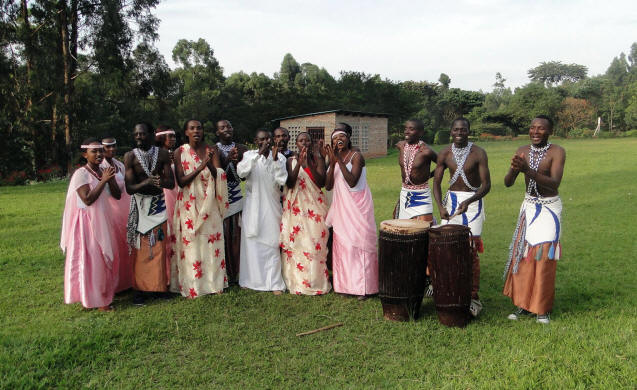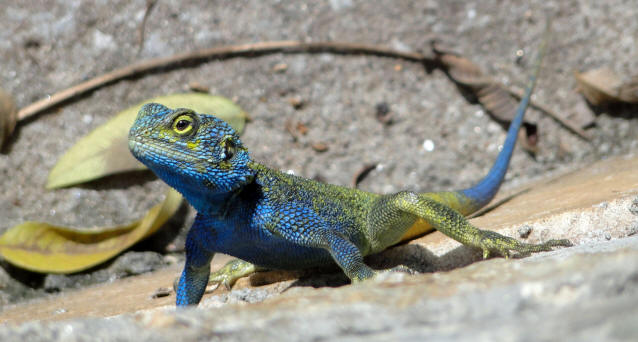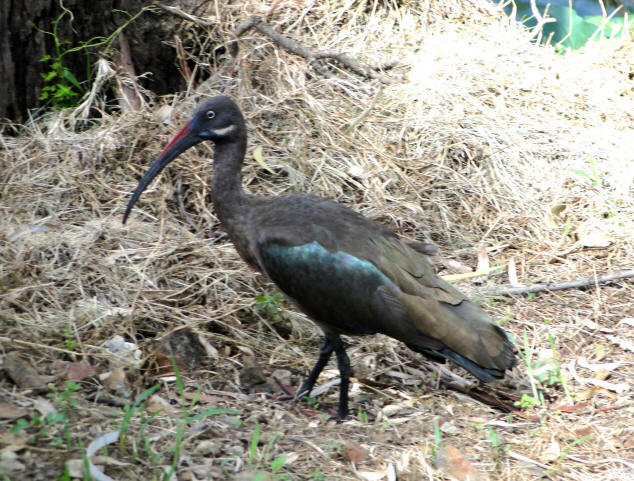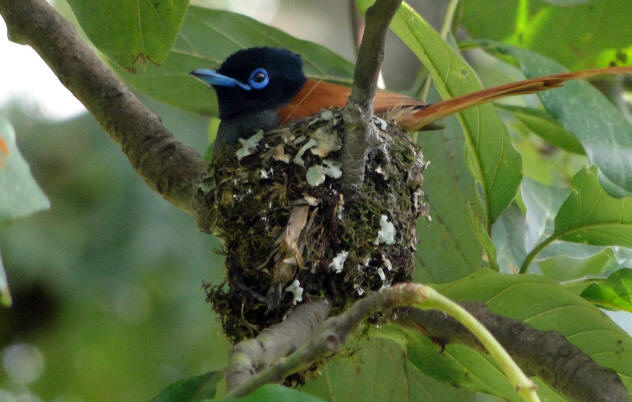Star Date: June 2010
Rwanda
Hello Dear Family & Friends!
Muraho! Amakuru? Nimeza.
(Hi – How are you? I’m fine. Rwanda)


‘Intore’, a dynamic traditional Rwanda dance.
“The best way to get rid of our enemies is to make them our friends.”
Anonymous
Louie Armstrong sings “What a Wonderful World” we live in. Joy abounds and strong, caring, helpful people can be found everywhere. But these aren’t the things that make the news. Life on this planet is a rollercoaster of events. Disasters happen around the globe. Atrocities immerge. CNN rushes in, takes a few photos to capture the horror, and pastes these pictures all over the media. These shocking images haunt us and instill fear. The reality of war or ‘conflicts’ is shocking and unbelievable, no matter where it takes place. How many of us have been to the land of the enemy in Vietnam, or Iraq, or Afghanistan, or Rwanda? If we had traveled there we would know that each country is full of people just like you and me. People wanting a job, a safe home, school for their children and enough food to eat. They consider the extremists in their country to be criminals, not terrorists; like a criminal in America who robs a bank and guns down innocent bystanders. Of all the countries we have traveled to, I consider parts of the large cities of America to be the most dangerous and yet we Americans are scared to travel abroad. We are gripped with fear of the unknown. The result is, “I’m never going to Africa, it’s dangerous there.” This is what inspires me to continue producing our webpage. It is important to know that great people are doing remarkable things all the time. As we say over and over, “No matter where you go worldwide, there are 95% good people and 5% #*$* causing problems.” Time to focus on the 95%. Current information helps dispel these fears. Thanks for sharing our website with as many people as you can. Help spread the word. With over 80,000 hits from 120 countries looking at our site monthly we know that an alternative to the negativity of mass media is vital.
Rwanda, is a small but progressive, forward thinking country in Central Africa. This ancient land ringed with active volcanoes and lush green hills hides half of the elusive mountain gorillas remaining on the planet. “Gorillas in the Mist.” American zoologist, Dian Fossey, lived among Rwanda’s threatened mountain gorillas, which she studied from 1963 until her death in 1985. She established the Karisoke Research Center, an international center for the study of gorillas, in Rwanda in 1967. You can still hike up 4-5 hours to her former camp area, highlighting the impact she had in the preservation of these magnificent creatures.
Expansive lakes are full of fishermen with nets; chanting and singing as they paddle to the beat. Colorful rural markets are bursting with a cornucopia of vegetables and fruit. The capitol, Kigale, is a small wanna be cosmopolitan city riding the wave of new foreign investment. No matter where you go smiles abound and the hearts of Rwandans welcome you in. With names such as Happiness, Innocent and Precious how could it be anything else?
Life is change. We all have things in our past that we wish had never happened. Rwanda is no different.

These authentic costumes, include intricate beading, painted shields and head pieces from plant fibers.

The energetic national dance troupe of Rwanda, Urugangazi.

“Gorillas in the Mist”
Genocide. We have all heard about it, shuddered, and forgotten it happened. Mankind is capable of doing to each other that which the animal kingdom couldn’t imagine. Worldwide over 100 million people were killed during the 20th Century alone. Most in bloody combat, others destroyed in neat, orderly little puffs of smoke as bombs are dropped from thousands of feet above. Unfathomable. Not wanting to dwell on Rwanda’s recent history as we crossed over the mountains from Uganda into northern Rwanda, we found all the shops closed in commemoration of the horrific events in which over 1 million Tutsis were killed by the Hutu “Interhamwe” forces or as neighbor turned on neighbor. A mere 15 years ago Tutsis and their sympathizers were brutally raped, tortured, then shot, bludgeoned, or hacked to death over a period of 100 days; the stench of death filled the country.
Hundreds of thousands fled to nearby Congo, Uganda or Tanzania. The international community ignored what was happening even though reports filtered out. No one in Rwanda escaped unscarred, whether victim or perpetrator. Emotional scaring remains as this tiny country, the most densely populated in Africa, slowly heals. A local prison was filled with hundreds of “genociders” serving from 10 years to life for their atrocities. When we were walking by they were all sitting in a large courtyard of the cement and barbed wire compound, dressed in bright orange, watching the government’s yearly film on the 100 day genocide against Tutsis, which started April 1994. A man offered to let us view the video but warned it was extremely violent. We declined. Seeing the Tutsi survivors begging in the streets, with hands and/or feet chopped off was enough.
The original Rwandans, the Twa Pygmies, were overrun by Hutus then Tutsis from the north in the 1600’s. Feudalism ruled until 1890 when the Germans decided to conquer and take a southern vacation for 26 years. The Belgians kicked them out and ruled until Independence in 1962. First the Hutus were in power, discriminating against the Tutsis, who fled the country and launched guerilla raids. Forming the RPF, they attacked Rwanda from Uganda until a peace accord was signed between the rebels and the Hutu government in 1993. When President Habyarimana’s plane was shot down returning from peace talks in Tanzania, a calculated final solution plan of revenge was implemented to clear the country of Tutsis and reformists once and for all. Gangs of youth and Hutu sympathizers, the “Interhamwe”, were supplied guns, machetes, and other weapons and given a free reign of terror by the government. One million people were slaughtered. Three million people fled the country and 7 out of 9 million citizens were displaced. The international community turned a blind eye. Months later the Tutsi led RPF took control in Rwanda. Hutu extremists fled to the Congo, and terrorized refugees in camps on the borders. Fighting broke out between the two factions, with 1 million refugees caught in the middle. The fighting escalated in neighboring Congo and they were caught up in Africa’s largest war to date, fighting over the D R Congo’s mineral wealth along with 8 other African states.
Rwanda’s Prime Minister Kambanda was the first head of state ever convicted of genocide. He revealed the intricate plans for its execution and many of the underlings were arrested; all currently behind bars. Ripe for revenge the RPF would have had incentive to continue the bloodbath but much to their credit, set about trying to rebuild a country still trembling in disbelief. The main action was to do away with any tribal division. Tutsis (15%) and Hutus
(80%) and the “Don’t forget about us” Twa Pygmies (1%) all became Rwandans. Possibly the only path towards a better future. President Kagame knows that it will take time but the country has made great strides in the last decade and are to be commended for their persistence and innovative thinking. Displaced persons have been resettled, unfortunately in former national parks, with over 300 people per sq kilometer, Rwanda is one of the smallest but most densely populated countries in Africa. With all this behind them the economy is picking up and foreign investment returning. With colonialism underground nowadays, conflict is a subtle or not so subtle part of the modern global business world. He who controls the ‘gold’, irrespective of what tribe (or nationality) is printed on their identity card, controls the world.
Everyone used to live side by side, and intermarry in Rwanda. In 1932 the then ruling Belgians employed the colonial approach of divide and conquer, declaring that any family that owned 10 cows or more would have an I.D. marked Tutsi (the pastoralists) – under 10 Hutu (farmers). Tutsis were set apart as leaders to control the Hutu majority. So the conflict began. The “Haves” vs the “Have- Nots”. There is even a booklet showing how to distinguish between the two tribes by measuring noses and height of the forehead. All ridiculous. Create chaos, create enemies. Tribal rivalry is at the core of most conflict in Africa. Guaranteed no one would have predicted so many people would be killed as the end product.

Mt. Nyiragongo (3470m -10,410ft) blew it’s top in 2002 and swallowed up most of Goma, in the Democratic Republic of the Congo, a mere 2 miles away. At night a large red cloud reflects the lava lake in the crater. This cloud can be seen up to 100 miles along Lake Kivu.

Shopping for tomatoes in one of the many colorful markets throughout Rwanda.

We spent an enjoyable afternoon with ‘Juma’ and his family.

Genuine smiles greet you at every stop.
When in a business I asked a young man next to me, “In looking at all these people how can you tell who is a Tutsi and who is a Hutu?” He really couldn’t answer. All people here now carry an I.D. stating they are Rwandan only. Changes for the better are taking place.
While walking the streets of Gisenyi on Lake Kivu, we met ‘Juma’ (alias). “Can I help you with something?” Wanting to practice English, one of his 7 languages, we invited him to walk and talk. After running our errands he and Joseph sat down for a long discussion. The next day we took him to lunch. His story is not uncommon. His mother, a Tutsi (or ‘T’ as they are commonly called here) fled to the Congo to escape being murdered like many of her family members. There she was forcibly impregnated by his father, a Ugandan. She returned to Rwanda when it was safe and left Juma behind, in the care of his father’s parents. There he remained until the age of 18, being shuffled between family members. He wanted to find his mother 3 years ago and live in more modern Rwanda, rather than his quiet village outside of Mbarara, Uganda. With only his Mother’s name, town and religion he sat outside the local mosque making enquiries. They were reunited, the proof of identity being the 3 large scars across his forehead, burned for identification as a baby. Reunification was more bitter than sweet. Juma’s mother had married a man upon returning to Rwanda and converted to Islam. Sadness struck again as the husband was diagnosed and died of Aids, infecting his wife and thus the two children 6 & 9. She was declared an unimportant 2nd wife by the mosque as his 11 other children fought over his possessions. She was destitute. Thrown into an oppressive situation Juma has helped support his new family while slowly trying to save for his last year of secondary school. He dreams of University someday. Sharp as a top he will do well when it finally happens. We agreed over lunch that Education is the key to change. Juma never asked us for help or money – only asked questions and sought advice.
Juma eagerly invited us to come home with him to meet the family the following day. Stopping by the market we bought bags of vegetables and walked to their little mud brick home past the mosque. We were welcomed by Safina and her 2 children. After looking at the families photo album, including baby & school photos and her former husband upon returning from Mecca, we all pitched in to peel and cut vegetables. Juma stated that it was disrespectful for men to help prepare meals and Joseph told him that it was time for him to learn some more modern customs, such as men helping with food preparation and clean-up. He told him, “Respecting each other and working together is important. The more rights women have the more rights men have.” Juma agreed and he and Joseph joined in the preparations. We cooked a tasty one pot meal over charcoal with potatoes, vegetables, greens and red beans. Everyone dived in like they hadn’t eaten such a meal in a while. After dinner, sitting in the little one room living room, we talked and talked about health. Safina would never be able to afford medicine for Aids as it progresses, so we talked about trying to eat healthier to postpone the symptoms. She was very inspired, especially when what we proposed was eating the cheapest food in the market, cutting out expensive oil, meat, and sugar from their diet, and adding lots of boiled water and raw garlic daily. She started calling her Uncle so he could come listen because he has cancer. I had cured myself from cancer 8 years ago by making changes in my life, stress, mind, attitude, and diet. Never returning to the doctor, except for a re-test 18 months later (which showed no cancer) I was proof that change in lifestyle works (click our ‘Thoughts on Health’ page). We asked her to instead relay all the information to Uncle that she had just learned. Sharing is the best way to pass information around. Away we went tired but happy to have shared an afternoon in their life. Juma later told us that his Mom had started the next day to make changes in their diet. She and her children have serious incentive to keep strong and healthy. Wherever we live, whatever our life’s path, change comes hard; but change we must.
And so it goes…………………………………..Next month a further look into Rwanda, past and present. Unless we learn from history we are bound to repeat it. Until then lets learn about mankind’s mistakes of the past but move on, remembering that things change for the better if each one of us keeps our thoughts and actions positive, showing compassion for those around us.
A lot has happened in the past couple of months. We are glad to finally get another webpage up. Hope you enjoy learning what Central Africa is like today. Keep Smiling! Glad you stopped by. Thanks for keeping in touch! Take care!

A heavy load of beans, probably around 75 pounds. Women were sorting the dried beans then carrying them into town.

Picturesque Lake Kivu is surrounded by lush vegetation with a backdrop of the 8 Virunga Volcanoes. Right across the lake, which stretches for over 100 miles, is the Congo.

Before…………… .

After………… Simply the product of overpopulation. Each generation claims yet another hill for food & shelter.
Love, Light & Laughter,
xoxoox Nancy & Joseph
Travel notes:
1.00 USD = 588.000 Rwanda Francs RWF
Huye (Butare):
National Museum of Rwanda: Rue de Kigale, in Huye. A wonderful museum highlighting the ethnological history of Rwanda. The museum, with its beautiful building was given to Rwanda by Belgium in 1989 to commemorate 25 years of independence. Home of the national dance troupe, Urugangazi, a lively group of men and women in authentic costumes, performing traditional music and dances. They are often invited to perform overseas. Excellent.
Call the National Museum for their performance schedule.

Large fruit bats ‘hanging around’.

Bright, multi-colored lizards everywhere.

Ibis looking for lunch.

Hidden nest.

